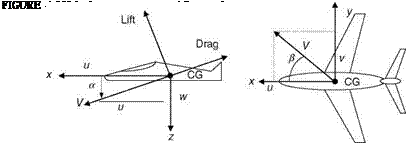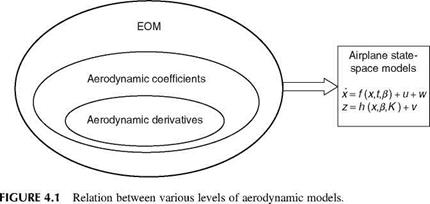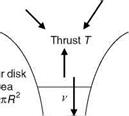Lateral-Directional Derivatives
Lateral-directional derivatives are defined as the sensitivities of the side force, the rolling moment, and the yawing moment with respect to small changes in side speed, roll rate, yaw rate, and aileron – and rudder-control surface deflections. These derivatives are, in general, difficult to estimate with a good degree of confidence.
|
Derivative |
WT Value |
(at 100 knots/1.87 km alt/ |
|
Cl„ (/rad) |
5.014 |
5.254 |
|
Cm„ (/rad) |
—0.57 |
—0.495 |
|
Cmq |
— 13 |
— 14.49 |
|
Cmde (/rad) |
—0.802 |
—0.911 |
Effect of change in side speed v/AOSS:
(Yv, Lb, Nb)
Yv is the change in the side force due to a small change in the side velocity v. The side force Y is given by
![]()
![]() pu2sc 2 Cy
pu2sc 2 Cy
and hence pU2S dCy
2 ~dv
Using v = bU, we obtain
This derivative is difficult to estimate. It is usually negative, since sideslipping causes the side force that opposes the sideward motion.
 |
||
Lb is the change in the rolling moment due to a change in sideslip. We have
Ci is the effective dihedral and it is negative for the positive dihedral. It is essential for lateral stability and control and hence considered as a preliminary design parameter.
Nb is the change in the yawing moment N due to a change in the side velocity. It is mainly caused by the side force on the vertical tail. Following the previous development for Lv, we obtain
![]()
![]() pUSbc 2Іг Cnb pU2Sbc 2I7 Cnb
pUSbc 2Іг Cnb pU2Sbc 2I7 Cnb
The vertical tail and related lever arm contribute to Cn. This contribution is positive and signifies the fact that due to positive sideslip this force creates a positive yawing moment, which in turn tries to reduce the sideslip thereby maintaining the static stability.
Effect of change in roll rate p:
(Yp, Lp, Np)
These derivatives arise due to the change in rolling angular velocity, roll rate p. The roll rate creates a linear velocity of the vertical, horizontal, and wing surfaces, causing a local change in the AOA of these surfaces and the lift distribution, which in turn causes the moment about the CG.
Yp is the change in side force due to a change in the roll rate. We have
|
|
|
|
|
|
![]() PUSbr 4m CYp
PUSbr 4m CYp
This derivative is not significant and is often neglected.
Lp is the change in the rolling moment due to a change in the roll rate p. It is known as a roll-damping derivative. The induced rolling moment is such that it opposes the rolling moment thereby providing dynamic stability to the aircraft. We have
|
|
|
|
|
|
x
Np is a change in the yawing moment due to a change in roll rate. It is given as
|
|
|
|
|
|
with usual definitions as in the previous case.
Effect of change in yaw rate r:
(Yr, Lr, Nr)
The yawing angular velocity, yaw rate, causes these derivatives. The yaw rate causes the change in the side force that acts on the vertical tail surface.
Yr is the change in side force due to a change in the yaw rate. We have
![]()
![]() (1 /m)dY/dr
(1 /m)dY/dr
pUSb 4m 4r
 |
||
Lr is the change in the rolling moment due to a change in the yaw rate r. We have
Nr is a change in the yawing moment due to a change in yaw rate. It is given as
with usual definitions as in the previous case.
Effect of change in aileron and rudder control surface deflection:
(YSa, LSa, NSa, YSr, LSr, NSr)
Ls and N8 are the primary control derivatives or control power. If the absolute magnitude of these derivatives is higher, then for a given deflection, more rolling and yawing moments are generated. This is regarded as higher control sensitivity for a given moment of inertia.
YSa = (1/m)d Y /88 a =
Similarly,
Ydr = (1/m)8Y/88r = ^ CySr (4.32)
N8 and L8 are cross-derivatives and will be useful if there is rudder-aileron interconnect for certain high-performance fighter aircraft or rotorcrafts.
Some important derivatives are explained next.
(a) Cn represents the directional static stability. If Cn > 0, then aircraft possesses static directional stability. Such an aircraft will always point into the relative wind direction and hence the directional stability is also called the weathercock stability, synonymous with the concept of the weathercock at airports, etc. At high angles of attack (HAOA) Cn will be affected significantly because the fin will get submerged in the wing – body wake. This derivative is of significant importance in dynamic lateral stability and control. It governs the natural frequency of the Dutch-roll oscillatory mode of the aircraft. It also contributes to the spiral stability of the aircraft.
(b) Ci is the rolling moment derivative (due to a small change in AOSS). It provides the dihedral stability for C < 0. The dihedral instability will contribute to the spiral divergence. A stable dihedral will tend to decrease the AOSS by rolling into the direction of yaw. Both C and Cn affect the aircraft Dutch-roll mode and spiral mode as will be discussed in Chapter 5.
(c) Ci is the damping-in-roll derivative and determines roll subsidence. The change in rolling velocity causes the change in rolling moment. The +ve roll rate induces a restoring/opposing moment and hence the derivative has generally —ve magnitude. It can also be considered as a design criterion, since it directly affects the design of ailerons.
(d) Cn is a cross-derivative that influences the frequency of Dutch-roll mode.
(e) Cn is the damping-in yaw parameter that contributes to damping of the roll-roll mode in a major way.
(f) Ci affects the aircraft spiral mode.
(g) Ci and Cn are important derivatives that represent the aileron control effectiveness and the adverse yaw derivative, respectively. Cn is an important lateral-directional control derivative.
(h) ![]() Cys, Chr, and C,
Cys, Chr, and C,
Cn is an important lateral-directional control derivative representing rudder effectiveness. Numerical values of certain lateral-directional derivatives are given in Table 4.6.
















